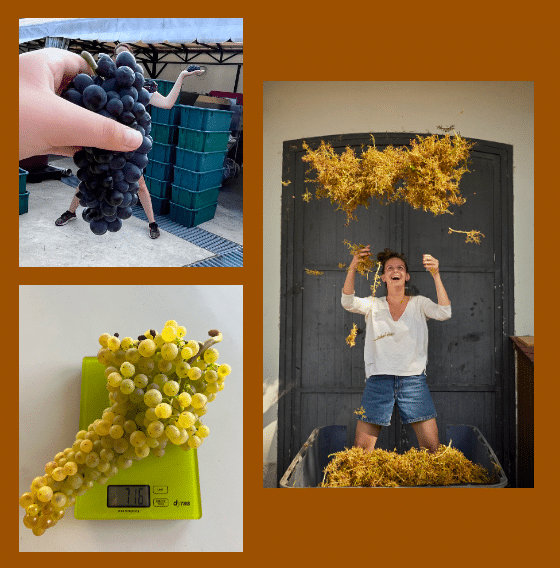Királyleányka – a little princess with great potential
Királyleányka is originally from Tranyslvania, the formerly Hungarian western part of Romania. Now it is often referred to as Hungarian indigenous grape variety. It is grown all over Hungary, typically in Mátra, Ászár–Neszmély, Etyek, Eger, Mór, Pannonhalma, South Balaton and Pécs wine regions. It’s often used in blends, for exapmle in the popular white blend of Eger wine regon, Egri Csillag. The world Királyleányka literally means little princess. Királyleányka is said to be a natural hybrid of Leányka and Kövérszőlő – this latest is one of the typical grapes of Tokaj wine region. The grape was introduced in Hungary in the 1970s. It was said to be identical with Fetească Regală, however comparison of their DNA profiles shows that Királyleányka and Fetească Regală from Romania are distinct varieties (Wine Grapes).

The wine made of Királyleányka has light yellow colour with greenish taint. It is slightly aromatic, delicate. It has a significant, but pleasant acidity, and this fresh acidity makes it a good blending partner for other, softer aromatic varieties. On the nose and palate it is full of fresh fruits and flowers. The lightly perfumed, grapey, light wine is a popular summer party wine nowadays.

Kúria White 2015
Here are some fabulous examples of Királyleányka:
This wine is a brillant example for showing the capacity of Királyleányka as a good blending partner – at this case with Szürkebarát (Pinot Gris)
Another good example for blending Királyleányka, this time to make a complex, full bodied white wine with aging potential. You will be surprised to see how young this wine still is!
The winery chose Királyleányka to be the base of their white blend because of its acidity.
A lovely, frutiy, crispy, fresh wine, it was bon – as the winemaker says – from the game of the Sun and the Wind.
- Thummerer Sparkling Wine, Eger
The Thummerers released their first bottle fermented sparkling wine las year, and just like in Egri Csillag, they use the indigenous Királyleányka grape along with Pinot Noir and Chardonnay. „Subtle nose with autolysis notes and citrus aromas. Fresh, vivid, crispy acidity, ethereal wine with a lot of creamy bubbles. On the palate citrus falvours dominate with apple and mineral notes. Great balance, nice long length” – wrote the membels of the panel of VinCE Magazine in their evaluation in the December issue, 2016.
The following is the chapter about Királyleányka in the multi-awarded book of Wine Grapes
Excerpt From: Robinson, Jancis; Harding, Julia; Vouillamoz, Jose. “Wine Grapes (9780062325518).” iBooks.
KIRÁLYLEÁNYKA – Hungarian variety producing light, aromatic whites.
Berry colour: white
PRINCIPAL SYNONYMS: Dánosi Leányka
VARIETIES COMMONLY MISTAKEN FOR KIRÁLYLEÁNYKA: FETEASCĂ REGALĂ * (Romania), Királyszőlő * (Hungary, but no longer cultivated)
ORIGINS AND PARENTAGE
Királyleányka, meaning ‘princess’, is said by some to be identical to FETEASCĂ REGALĂ from Romania (Galet 2000) and by others to be a natural cross between Kövérszőlő (GRASĂ DE COTNARI) and LEÁNYKA originating from Transilvania, now in central Romania, that was introduced to Hungary in the 1970s (Rohály et al. 2003). However, comparison of their DNA profiles shows that Királyleányka and Fetească Regală from Romania are distinct varieties (Vouillamoz), and the proposed parentage has been rejected by DNA profiling (Galbács et al. 2009), thus challenging the “possible Romanian origin of Királyleányka. Leányka is possibly one of the parents of Királyleányka.
VITICULTURAL CHARACTERISTICS
Mid budding and ripening, medium to high yields. Small, compact bunches of small berries. Susceptible to botrytis bunch rot and downy mildew.

WHERE IT’S GROWN AND WHAT ITS WINE TASTES LIKE
This widely grown variety (942 ha/2,328 acres in Hungary in 2008) produces wines that are fresh and lightly perfumed, often grapey, making it particularly popular in the last ten years as a typical summer or party wine. Its fresh acidity makes it a good blending partner for other, softer aromatic varieties and it seems to do best in Mátra and Eger. Recommended producers include Bolyki (Eger), Bujdosó and Ottó Légli (Balatonboglár), Etkeki Kúria (Etyek), Tamás Szecskő and Mátyás and Zoltán Szőke (Mátra).”
Excerpt From: Robinson, Jancis; Harding, Julia; Vouillamoz, Jose. “Wine Grapes (9780062325518).” iBooks.
Comments ( 8 )
-
Trackback: ทางเข้า lucabet
-
Trackback: darknetabacusmarket.com
-
Trackback: unieke reizen
-
Trackback: Hormone Screening Test
-
Trackback: PLAYTECH ผู้ให้บริการชั้นนำคุณภาพระดับโลก
-
Trackback: รับจัดงานอีเว้นท์
-
Trackback: gambia senegal
Comments are closed.







Trackback: ตู้เชื่อม